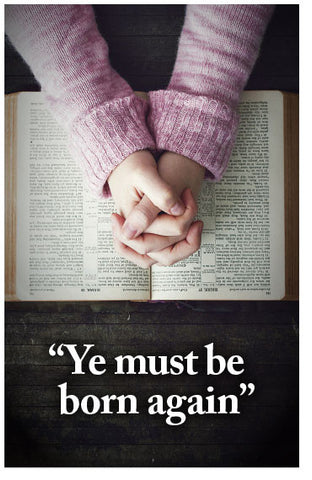Enlightening the World (KJV)
Special-Order Folded Tract
 NOTE: This item is custom-printed to order (click for more details).
NOTE: This item is custom-printed to order (click for more details).
This tract is from our print-on-demand library, and is not kept in stock. Select the options below, and we will custom-print a batch just for you. Because this item is custom-printed, you can add your custom imprint to the back page at no extra cost.
- Estimated shipping date: Monday, January 12 (Click for more details)
- SKU:
- Discounts: Discount coupons do not apply to this item
- Format: Folded Tract
- Size: 3.5 inches x 5.5 inches
- Pages: 6
- Imprinting: Available with 5 lines of custom text
- Version: KJV
- Returns: Because this item is custom-printed to order, it cannot be returned.
Show all item details
The full text of this tract is shown below in the KJV version. (Do you want to print this tract in a different version than the one listed? Contact us and let us know what you're looking for—we may be able to create the alternate version for you at no charge.)
Liberty Enlightening the World was the original title given to what is now more commonly called The Statue of Liberty. Situated on Liberty Island in New York Harbor, the statue was a gift from France as a gesture of friendship and a tribute to the United States’ devotion to democracy and freedom.
Designed by Frederic Auguste Bartholdi, the statue was constructed by hammering huge sheets of copper into shape over an iron framework. It represents a regal woman who has just escaped from the chains of slavery which lie at her feet. Her right hand holds aloft the burning torch of liberty and in her left hand she holds a book of law which is inscribed with the date of the Declaration of Independence—July 4, 1776. She is draped in flowing classical robes and wears a spiked crown.
The figure was built in Paris, disassembled and shipped to New York where a pedestal had been prepared for it. It was dedicated by President Grover Cleveland on October 28, 1886. This gigantic statue has a height of nearly 152 feet and a weight of 225 tons. With its base and pedestal it stands more than 300 feet. Her right arm measures 42 feet, her index finger 8 feet and her nose 4 feet 6 inches. In the hollow interior of the statue are an elevator and two spiral stairways which lead into the figure’s crown where windows provide a spectacular view of New York Harbor.
In the decades that have followed, The Statue of Liberty has become known as a symbol of freedom throughout the world. In 1903 a poem written by American poet Emma Lazarus was inscribed on a bronze plaque and attached to the base of the statue. The final lines of this poem have become familiar and loved by many:
Give me your tired, your poor,
Your huddled masses yearning to breathe free,
The wretched refuse of your teeming shore.
Send these, the homeless, tempest-tost to me,
I lift my lamp beside the golden door!
This stirring poem gave added meaning to The Statue of Liberty as a symbol of hope for those seeking freedom. It gave expression to one of the most significant roles of the statue—that of being a symbol of America as an open door for people from the rest of the world. From 1892 to 1954 more than 17 million immigrants from every part of Europe, fleeing hunger, turmoil and oppression, passed by The Statue of Liberty—their first glimpse of a New World of hope, freedom and opportunity—on the way to the nation’s first immigration station on nearby Ellis Island. Today, almost half of all living Americans can trace their heritage to one or more family members who first stepped onto American soil at Ellis Island.
Though not as imposing a structure as The Statue of Liberty on Liberty Island, the Christian has his own “statue of liberty” which represents much more than freedom from mere physical slavery. The Cross of Calvary, though just a crude edifice of wood is a monument to the liberation from sin’s penalty, just as the chains at the feet of The Statue of Liberty represent freedom from the chains of slavery. In order to be assured of eternal blessing with the Lord in heaven we must have the sins that separate us from Him atoned for. This is just what the Lord Jesus Christ did for us on the Cross of Calvary. He suffered, bled and died for the sins of the whole world. All one needs to do to become personally free from his sins is to confess them to Jesus and believe He died for them on that cross. He arose from the dead the third day and is now ascended to the glory from where His own are waiting momentarily for His return. To be caught up with Him and to be forever with the One who loved us and gave Himself for us is the blessed hope of every Christian. But while here, the Cross is a constant reminder of Jesus’ sacrificial death and His love in freeing us from sin’s slavery.
Dear reader, do you know the liberty of having your sins forgiven? Just as the millions of immigrants who came to this land seeking a new life passed by that symbol of liberty, so you can experience a new life as you, by faith, pass by Calvary’s Cross, confess your sins, accept the work done there and enter into that “glorious liberty” (Romans 8:21). They are truly beautiful sentiments expressed in Emma Lazarus’ poem beckoning to those in need, but hear the words of the Lord Jesus: “Come unto Me, all ye that labor and are heavy laden, and I will give you rest” (Matthew 11:28). His words are truth and His love is matched by His power to deliver. Upon acceptance of Christ’s sacrificial death in your place you become a “new creature in Christ Jesus” (2 Corinthians 5:17)—“old things are passed away; behold, all things are become new.” As The Statue of Liberty represents liberation to the citizen, the work of Calvary’s Cross liberates the soul.
The seven rays in Liberty’s crown represent the seven seas and the seven continents. This reminds us of the universality of the work done for mankind by the Lord Jesus—”For God so loved the world, that He gave His only begotten Son, that whosoever believeth in Him should not perish, but have everlasting life” (John 3:16). He also wore a crown but it was not like Liberty’s sign of royalty. It was a crown of thorns—a further display of the mockery, pain and humiliation He bore when He was made sin for us (2 Corinthians 5:21).
The book of the law held in Liberty’s left hand reminds us that we have been redeemed from the law—“Christ is the end of the law for righteousness to every one that believeth” (Romans 10:4). It is not through any works or law-keeping on our part, but through faith alone in the work of Christ on Calvary that we are saved from our sins.
Liberty’s torch is a beacon to all who are near enough to see it. How much greater is the Lord Jesus Christ who says: “I am the Light of the world: he that followeth Me shall not walk in darkness, but shall have the light of life” (John 8:12). His light will never go out and He is ready and willing to bring enlightenment to all who seek Him. Won’t you let the Light of the World be your Saviour? —M.S.J.













